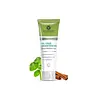What's inside
What's inside
 Key Ingredients
Key Ingredients

 Benefits
Benefits

 Concerns
Concerns

No concerns
 Ingredients Side-by-side
Ingredients Side-by-side

Water
Skin ConditioningXanthan Gum
EmulsifyingSodium Acrylates Crosspolymer-2
AbsorbentSodium Allantoin PCA
Skin ConditioningChlorphenesin
AntimicrobialPhenoxyethanol
PreservativeGlycerin
HumectantPropanediol
SolventSodium Hyaluronate
HumectantCentella Asiatica Extract
CleansingCinnamomum Zeylanicum Bark Extract
AntimicrobialPanthenol
Skin ConditioningNiacinamide
SmoothingRoyal Jelly
Arbutin
AntioxidantResveratrol
AntioxidantPolyquaternium-7
Ethylhexylglycerin
Skin ConditioningAlcohol Denat.
AntimicrobialSodium Chloride
MaskingTetrasodium EDTA
Magnesium Nitrate
Methylchloroisothiazolinone
PreservativeMethylisothiazolinone
PreservativeWater
Skin ConditioningCocamide DEA
EmulsifyingGlycerin
HumectantCocamidopropyl Betaine
CleansingAmmonium Laureth Sulfate
CleansingAcrylates Crosspolymer-4
Emulsion StabilisingSalicylic Acid
MaskingSodium Lauroyl Sarcosinate
CleansingPhenoxyethanol
PreservativeAllantoin
Skin ConditioningPanthenol
Skin ConditioningPEG-150 Distearate
EmulsifyingPolysorbate 20
EmulsifyingSodium Hydroxide
BufferingHamamelis Virginiana Extract
AntiseborrhoeicParfum
MaskingSodium Benzoate
MaskingDisodium EDTA
Magnesium Chloride
Ethylhexylglycerin, Alcohol Denat., Sodium Chloride, Tetrasodium EDTA, Magnesium Nitrate, Methylchloroisothiazolinone, Methylisothiazolinone, Water, Cocamide DEA, Glycerin, Cocamidopropyl Betaine, Ammonium Laureth Sulfate, Acrylates Crosspolymer-4, Salicylic Acid, Sodium Lauroyl Sarcosinate, Phenoxyethanol, Allantoin, Panthenol, PEG-150 Distearate, Polysorbate 20, Sodium Hydroxide, Hamamelis Virginiana Extract, Parfum, Sodium Benzoate, Disodium EDTA, Magnesium Chloride
 Reviews
Reviews

Ingredients Explained
These ingredients are found in both products.
Ingredients higher up in an ingredient list are typically present in a larger amount.
Glycerin is already naturally found in your skin. It helps moisturize and protect your skin.
A study from 2016 found glycerin to be more effective as a humectant than AHAs and hyaluronic acid.
As a humectant, it helps the skin stay hydrated by pulling moisture to your skin. The low molecular weight of glycerin allows it to pull moisture into the deeper layers of your skin.
Hydrated skin improves your skin barrier; Your skin barrier helps protect against irritants and bacteria.
Glycerin has also been found to have antimicrobial and antiviral properties. Due to these properties, glycerin is often used in wound and burn treatments.
In cosmetics, glycerin is usually derived from plants such as soybean or palm. However, it can also be sourced from animals, such as tallow or animal fat.
This ingredient is organic, colorless, odorless, and non-toxic.
Glycerin is the name for this ingredient in American English. British English uses Glycerol/Glycerine.
Learn more about GlycerinPanthenol is a common ingredient that helps hydrate and soothe the skin. It is found naturally in our skin and hair.
There are two forms of panthenol: D and L.
D-panthenol is also known as dexpanthenol. Most cosmetics use dexpanthenol or a mixture of D and L-panthenol.
Panthenol is famous due to its ability to go deeper into the skin's layers. Using this ingredient has numerous pros (and no cons):
Like hyaluronic acid, panthenol is a humectant. Humectants are able to bind and hold large amounts of water to keep skin hydrated.
This ingredient works well for wound healing. It works by increasing tissue in the wound and helps close open wounds.
Once oxidized, panthenol converts to pantothenic acid. Panthothenic acid is found in all living cells.
This ingredient is also referred to as pro-vitamin B5.
Learn more about PanthenolPhenoxyethanol is a preservative that has germicide, antimicrobial, and aromatic properties. Studies show that phenoxyethanol can prevent microbial growth. By itself, it has a scent that is similar to that of a rose.
It's often used in formulations along with Caprylyl Glycol to preserve the shelf life of products.
Water. It's the most common cosmetic ingredient of all. You'll usually see it at the top of ingredient lists, meaning that it makes up the largest part of the product.
So why is it so popular? Water most often acts as a solvent - this means that it helps dissolve other ingredients into the formulation.
You'll also recognize water as that liquid we all need to stay alive. If you see this, drink a glass of water. Stay hydrated!
Learn more about Water